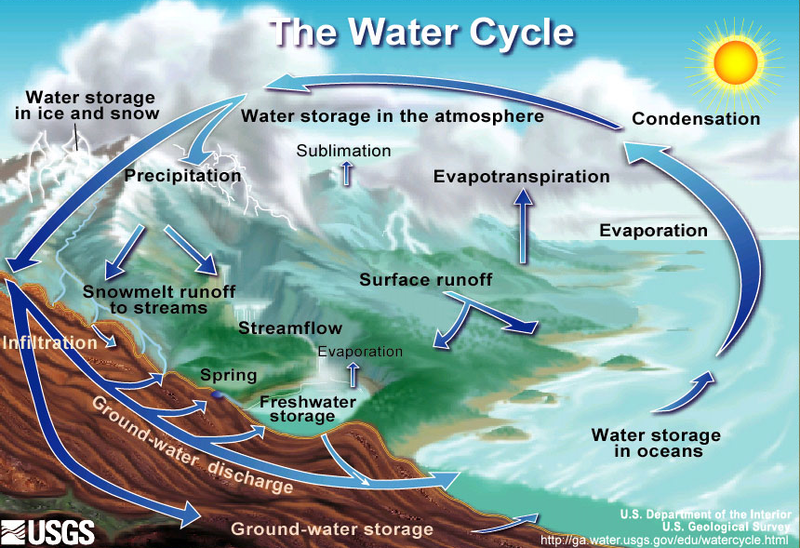The next block of material concerns water in the atmosphere. We will begin by describing the physics behind the important processes of evaporation and condensation. The concepts of relative humidity and dew point temperature will be explained. We will then show how the combination of air temperature, humidity, and winds relate to human comfort or discomfort and what is meant by windchill temperature and heat index. Next the process of cloud formation will be described. This will lead us to severe weather development since the heat released as clouds form provides much of the the energy for thunderstorms, tornadoes, and hurricanes.
Water is the only substance that exists in all three phase states (gas, liquid, and solid) at the temperatures found on the Earth. The concentration of the invisible gas water vapor varies greatly from place to place, and from time to time. In warm tropical locations close to the surface, water vapor can be up to 4% of the atmospheric gases. In cold polar regions, there is just a trace amount.
Water vapor is extremely important in the atmosphere because:
The diagram below shows the energy transfers that occur as water changes phase. Water vapor has the highest internal energy per gram of water, followed by liquid water, and then ice. Any phase change from a lower to a higher internal energy state requires the addition of energy, while any phase change from a higher to a lower internal energy state involves a release of energy. The energy that is added or removed as water changes phases is called latent heat. Latent literally means "hidden". In this context it means that although energy must be added to liquid water to make it evaporate (liquid to gas), there is no measurable change in the temperature of the water. (When the water condenses, gas to liquid, the same amount of energy is released with no measurable change in temperature of the water). Energy which is used to change the measured temperature of a substance is called sensible heat. For example, to raise the temperature of liquid water from 20°C to 30°C requires the addition of sensible heat and to lower the temperature of liquid water from 30°C to 20°C requires the removal of sensible heat.
| Deposition 680 cal/g Energy Released to environment (heating) |
||||
 |
||||
 |
Freezing 80 cal/g  Melting |
 |
Condensation 590 cal/g  Evaporation |
 |
 |
||||
| Energy taken from Environment (cooling) Sublimation 680 cal/g |
||||
The calorie (cal) is a physical unit for measuring energy. It is defined as the amount of energy required to raise the temperature or one gram of liquid water by 1 degree Celsius. Notice from the diagram above how this compares to the tremendous amount of energy required or released per gram of water that is undergoing phase changes.
The processes of melting, evaporation, and sublimation absorb energy. This added energy causes the molecules to change their bonding pattern. In the Earth system, this energy must be supplied by the surrounding environment. Thus, these phase changes result in cooling of the surrounding environment.
The energy absorbed is latent heat and goes back to the environment when the phase changes reverse. In the Earth system, this energy is released to the surrounding environment. Thus, condensation, freezing, and deposition result in warming the surrounding environment.
In the atmosphere, phase changes between liquid and gas are the most important. Make sure that you understand that evaporation of water results in cooling of the surrounding environment and that condensation of water results in warming the surrounding environment.
The water cycle refers the continuous movement of water on, above, and below the surface of the Earth. Water can change phase among liquid, gas (water vapor), and solid (ice) at various places in the cycle. The importance of the water cycle for life on land cannot be overstated ... without the water cycle, most of the terrestrial life on Earth could not exist. You should be familar with the basics of the water cycle and the use of the terms evaporation, condensation, precipitation, and evapotranspiration as described in the next paragraph.

|
Energy from the sun drives the water cycle. (Remember energy must be added to liquid water to cause it to evaporate). Liquid water on or slightly below the Earth's surface evaporates into the air, becoming the gas water vapor. Close to 90% of the water vapor in the atmosphere evaporated from the oceans and to a much smaller degree from lakes. Water is also evaporated from the land surface (out of soils) or transpired by plants. These processes on land are often lumped together and called evapotranspiration. Thus, the dominant process near the Earth's surface is evaporation (liquid to gas), acts to remove energy from the Earth's surface. Rising air currents carry water vapor up into the atmosphere, which cools the air, causing the water vapor to condense into tiny droplets of liquid water (or tiny ice crystals), forming clouds. This process, condensation (gas to liquid), releases energy up in the atmosphere where clouds form. In fact the water cycle transports energy ... removing it from the surface via evaporation and delivering it in the middle and upper troposphere where clouds form. When cloud droplets grow large enough they fall to the surface as precipitation. Much of the water on the surface of the Earth collects in the oceans, but it can also be stored as groundwater or ice. Eventually it evaporates again to again move through the water cycle.